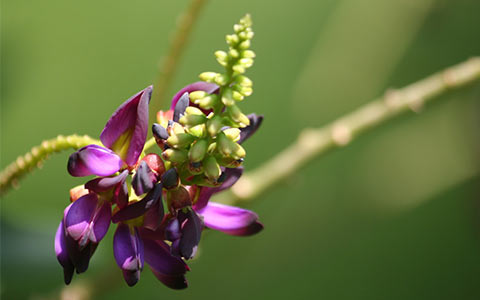
Keep your trees from being engulfed and killed by invasive kudzu vines. Knowing how to stop and control kudzu vines will help you save your trees, shrubs, and plants.
72tree.com assembled the following information about kudzu vines to help you understand their destructive nature and keep them from causing catastrophic damages to your trees.
Kudzu Vines and Trees
Kudzu vines can trail or climb. When they climb trees, they practically glue themselves to the bark of their host as they climb. Once breaching the canopy, the vine spreads rapidly, causing extreme shading of the tree.
If the affected tree doesn’t decline from girdling, it will certainly die once the vine completely overshadows the canopy unless immediate action is taken.
How To Safely Remove Kudzu from a Tree – The following steps will help you stop kudzu vines from killing your trees.
• Locate and cut the vine’s lower-most growth at the base of the tree
• Apply a 50% solution of triclopyr to the vine’s stumps to kill the roots
• Let the vine die on the tree. Pulling it off may cause severe bark damage.
Tip: Persistent weeding, mowing, and/or grazing (especially during the growing season) will deter the vine from reestablishing itself.
Kudzu Invasive Species
Kudzu (Pueraria montana var. lobata) vines are fast-growing, woody, hairy, trailing, or climbing vines that can grow to lengths of 100 feet with a massive taproot. The vine has large compound leaves with three broad leaflets. The plant bears long flower clusters of late-blooming reddish to purple flowers and brown, hairy, flattened seed pods.

Introduction to the US – Kudzu, native to Asia, was introduced to the United States in the late 1800s as a means of erosion control, livestock forage, and ornamental purposes (introduction occurred in 1876 at the Philadelphia Centennial Exposition where it was exhibited as an ornamental vine).
Plant Reproduction – Kudzu’s spread is primarily vegetative by taking root at nodes where the vines contact soil and subsequently form entirely new plants. The plant can also spread by seed, but few viable seeds are found in each pod.
Plant Growth and Habitat – Pueraria montana grows well in multiple habitats and soil types. Its most aggressive growth rate occurs where winters are mild, average summer temperatures are above 80°F, and annual rainfall reaches or surpasses 40 inches. However, the plant’s robust root system helps it survive summer or extended drought conditions. In areas where the plant successfully establishes itself, it can be found in abundance along roadsides, old/abandoned fields, forest edges, and other sunny areas.
Since its introduction, kudzu has spread fervently. It is currently present from New York to Florida and from nearly the entire eastern seaboard as far west as Arizona (Oregon and Washington have also reported confined cases of the species).
USDA Classification – In 1953, the United States Department of Agriculture (USDA) removed this plant species from its list of allowable cover plants. Then in 1970, kudzu was listed as a common weed of the South.
Note: By growing up to 12 inches per day, this invasive species can out-compete and kill everything from grasses to mature trees, crowding and shading them.

Kudzu Control and Prevention
Effective control methods of Pueraria montana depend on the size and location of the infestation. Consider the following:
Small or Poorly-Established Patches – These can usually be eliminated by repeated weeding, mowing, and/or grazing during the growing season.
Large or Well-Established Infestations – While weeding, mowing, and/or grazing effectively slow this type of infestation, it will typically not kill the roots of the larger plants.
These infestations can also be controlled with a foliar solution of 2% to 3% glyphosate or triclopyr plus a 0.5% non-ionic surfactant to thoroughly wet all the leaves.
After surface vegetation is controlled, you can dig and cut into the central root system and apply a 50% solution of glyphosate or triclopyr to the wounded roots.
When an infestation encroaches on desired vegetation, avoid using chemical control methods and manually remove the plant(s).
Tip: All treatments should be monitored for multiple growing seasons to prevent re-sprouting.
Advisory: When using any herbicide or pesticide, follow all directions/instructions on the label. “The label is the law!”
Kudzu (Pueraria montana var. lobata)
In this article, you discovered essential information about kudzu vines, how to stop them from killing your trees, and how to eliminate them altogether.
By taking swift action to control this highly invasive plant species, you can prevent your trees and landscape from being over-grown and snuffed out.
When you ignore a kudzu infestation, you are potentially signing a death warrant for all vegetation in its path, ranging from grasses to mature, healthy trees.
Sources:
ncforestservice.gov/publications/Forestry%20Leaflets/IS08.pdf
invasivespeciesinfo.gov/terrestrial/plants/kudzu
invasive.org/browse/subthumb.cfm?sub=2425&start=1
eddmaps.org/distribution/usstate.cfm?sub=2425
npgsweb.ars-grin.gov/gringlobal/taxon/taxonomydetail?id=314966